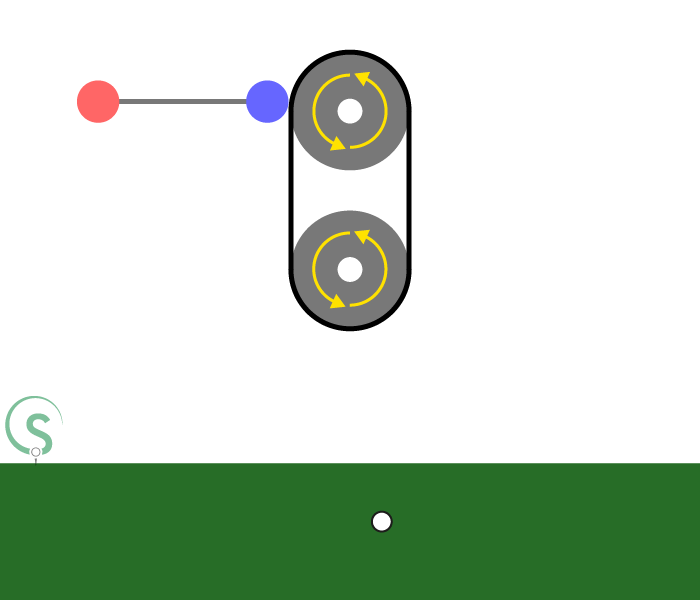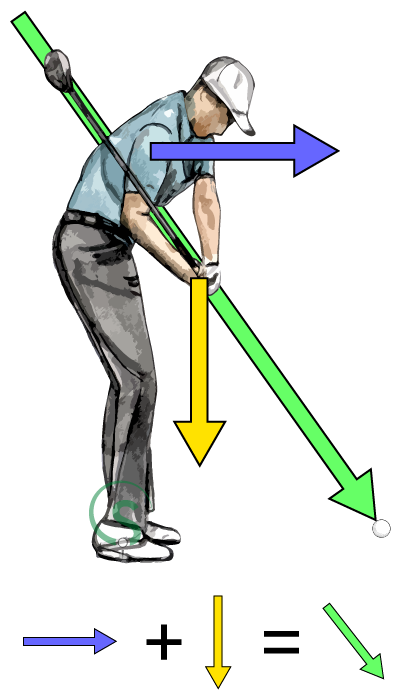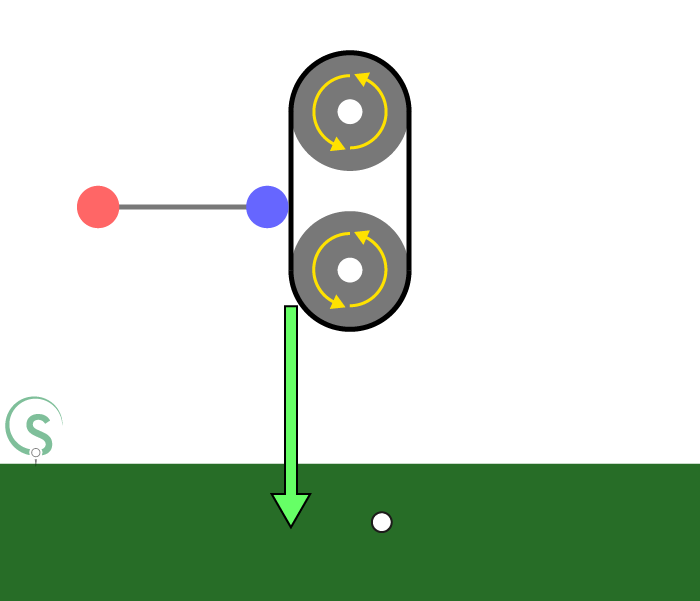Aiming Point
& The Endless Belt
What do you aim at when playing golf? Depending where you’re playing from, you could be aiming to hit the ball down the middle of the fairway, onto the green, or even in the hole. That’s one type of aim: your intended target. Another aim is the golf ball itself. You’ll be aiming to hit the ball solidly with the clubface, preferably the “sweet spot”.(1) So here are two obvious aims in golf: to hit the ball properly and to move the ball to a particular location. In The Golfing Machine, Mr Kelley describes a third aim, something he calls the Aiming Point.(2)
Before we explore the Aiming Point, let’s first look at another concept from The Golfing Machine; The Endless Belt Effect.(3) The Endless Belt is a simplified model of a golf swing. It's designed to demonstrate the two different ways of moving the golf club during the downswing. The model is comprised of two rotating pulleys connected by a belt. Attached to the belt is a golf club. On our model below, the blue circle represents the hands, and the red circle the clubhead. As the pulleys rotate, the golf club moves around this machine.
Before we explore the Aiming Point, let’s first look at another concept from The Golfing Machine; The Endless Belt Effect.(3) The Endless Belt is a simplified model of a golf swing. It's designed to demonstrate the two different ways of moving the golf club during the downswing. The model is comprised of two rotating pulleys connected by a belt. Attached to the belt is a golf club. On our model below, the blue circle represents the hands, and the red circle the clubhead. As the pulleys rotate, the golf club moves around this machine.

You’ll notice the club moves in two different ways on this model. Firstly, “linear travel” where on the hands and clubhead are moving in a straight line at the same speed(4) and then “angular travel” where the hands and clubhead move in a circular fashion around a pulley. During angular travel the hands and clubhead are moving at the same RPM but at different speeds as the clubhead travels a further distance than the hands over the same period of time.(5)
Mr Kelley describes three properties of the Endless Belt model that affect clubhead speed during angular travel.(6) These are: the radius, the belt speed, and the pulley diameter.(7)
Translating these properties into a real swing, you would extend the radius by using a longer shafted club, you would increase the belt speed by simply moving your hands faster, and you would enlarge the pulley diameter by increasing the distance between your hands and your body, i.e. standing further away from the ball.(8)
If you cast your mind back to the Power Package you can see how linear and angular travel relate to the five stage sequence of accumulation, loading, storing, delivery and release.(9) During linear travel the hands are maintaining their relationship to the clubhead by moving at the same speed. This is delivering the stored out-of-line power accumulators. Once the hands and clubhead have been delivered to their intended point on the downswing, the power accumulators start to release their stored potential by moving towards their in-line conditions.(10) This period of release, where the clubhead increases in speed, is represented by the angular travel on the Endless Belt. So what, during the downswing, changes linear travel (delivery) into angular travel (release)? The release begins as soon as you start to straighten the right arm on the downstroke.(11) Or in other words, once you start to move the First Power Accumulator towards its in-line condition. This can occur at any point on the downswing from the top, to near impact, so long as there is enough time to release the accumulators sufficiently.(12)
Mr Kelley describes three properties of the Endless Belt model that affect clubhead speed during angular travel.(6) These are: the radius, the belt speed, and the pulley diameter.(7)
Translating these properties into a real swing, you would extend the radius by using a longer shafted club, you would increase the belt speed by simply moving your hands faster, and you would enlarge the pulley diameter by increasing the distance between your hands and your body, i.e. standing further away from the ball.(8)
If you cast your mind back to the Power Package you can see how linear and angular travel relate to the five stage sequence of accumulation, loading, storing, delivery and release.(9) During linear travel the hands are maintaining their relationship to the clubhead by moving at the same speed. This is delivering the stored out-of-line power accumulators. Once the hands and clubhead have been delivered to their intended point on the downswing, the power accumulators start to release their stored potential by moving towards their in-line conditions.(10) This period of release, where the clubhead increases in speed, is represented by the angular travel on the Endless Belt. So what, during the downswing, changes linear travel (delivery) into angular travel (release)? The release begins as soon as you start to straighten the right arm on the downstroke.(11) Or in other words, once you start to move the First Power Accumulator towards its in-line condition. This can occur at any point on the downswing from the top, to near impact, so long as there is enough time to release the accumulators sufficiently.(12)

During the downswing, the golf club’s on plane motion is a result of two different forces working together. One is an outward force provided by the turning shoulders and the other is a downwards force provided by the straightening right arm.(13) With these two forces working together they keep the clubshaft on plane and provide the motion for a three dimensional impact; the clubhead moving downwards, outward and forwards through the impact interval.(14)
Now we understand release is a result of the straightening right arm, and this straightening right arm is producing a downward force. With this in mind we can discuss the Aiming Point. The Aiming Point is a location on the ground where you are aiming the thrust of your right arm. You can feel that thrust by using the pressure points discussed in the Power Package chapter.(15) The Aiming Point is an alternative to aiming for the ball. Instead, you move your attention to another place on the ground and concentrate on directing force at that point. This is advantageous in two ways: firstly it ensures you are hitting down on the ball,(16) something people can struggle with; and secondly you can ignore the ball altogether, so you aren’t making subconscious adjustments for impact.(17)
So where on the ground is the Aiming Point? On the Endless Belt model that’s easy to see. If you were to trace a line from the linear travel to the ground it would be there, where the right arm would be thrusting to initiate the release, the start of the angular motion around the pulley.
Now we understand release is a result of the straightening right arm, and this straightening right arm is producing a downward force. With this in mind we can discuss the Aiming Point. The Aiming Point is a location on the ground where you are aiming the thrust of your right arm. You can feel that thrust by using the pressure points discussed in the Power Package chapter.(15) The Aiming Point is an alternative to aiming for the ball. Instead, you move your attention to another place on the ground and concentrate on directing force at that point. This is advantageous in two ways: firstly it ensures you are hitting down on the ball,(16) something people can struggle with; and secondly you can ignore the ball altogether, so you aren’t making subconscious adjustments for impact.(17)
So where on the ground is the Aiming Point? On the Endless Belt model that’s easy to see. If you were to trace a line from the linear travel to the ground it would be there, where the right arm would be thrusting to initiate the release, the start of the angular motion around the pulley.

For “people shaped golfers” the Aiming Point is where the straightening right arm is directing its thrust. The location of the Aiming Point is affected by three variables. They are: clubshaft length, hand speed, and release point.(18) The longer the clubshaft is, the further back (i.e. further away from the target) the Aiming Point will be. This is due to the “conservation of angular momentum” which tells us longer clubs with greater mass take longer to release compared to shorter clubs when subjected to the same force.(19) The faster the hands move during the downswing, the further back the Aiming Point will be. This is because the quicker the hands move, the less time you have to sufficiently release the accumulators for impact, so the sooner you must start release. Also increasing hand speed is dependant on straightening the right arm sooner, which causes release.
Lastly, and most obviously, the release point. The later you leave release, the closer the Aiming Point will be to the ball. The sooner you release the further back the Aiming Point will be.
Lastly, and most obviously, the release point. The later you leave release, the closer the Aiming Point will be to the ball. The sooner you release the further back the Aiming Point will be.
